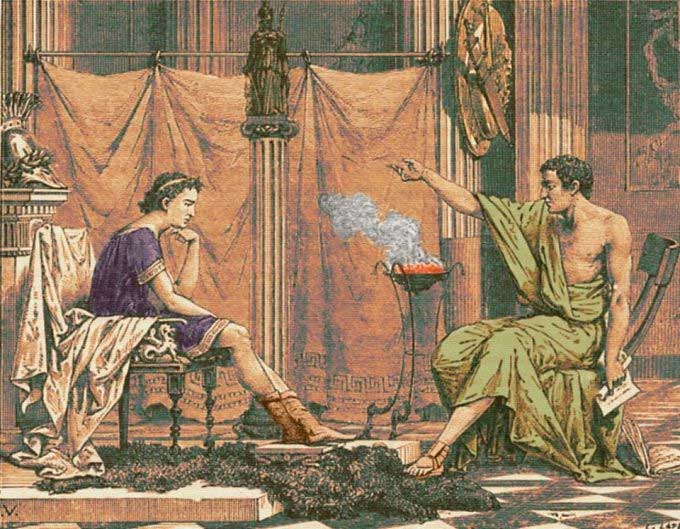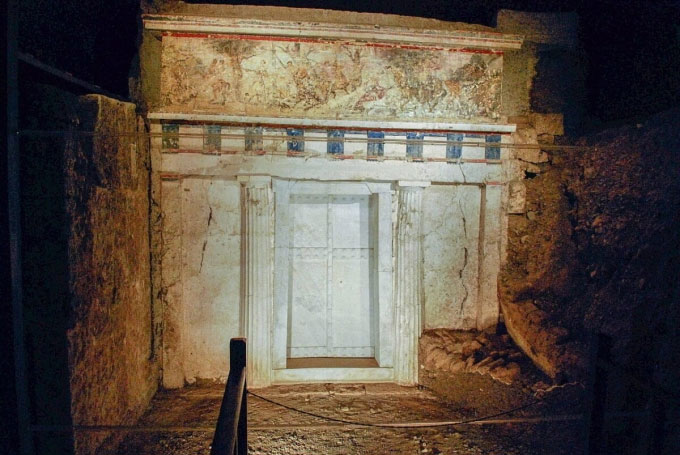Cloth suspected to be the legendary purple cloak of Alexander the Great
A purple and white cotton cloth discovered in a royal tomb half a century ago may be the cloak of Alexander the Great.
One of the many privileges enjoyed by the kings of ancient Macedonia was wearing purple , and Alexander the Great certainly took full advantage of this royal privilege. Experts believe he wore purple at every opportunity. New research in the Journal of Field Archaeology suggests that one of his most famous purple outfits may have been unearthed, IFL Science reported on October 30.

Illustration of Alexander the Great wearing purple. (Photo: Sun).
Alexander the Great used his privilege of wearing purple almost every day , according to the historian Ephippus of Olynthus, an ancient Greek author. He rarely went anywhere without his long, light purple cloak, called a chiton or sarapis . In the new study, Antonis Bartsiokas of the Democritus University of Thrace and his colleagues suggest that the cloak was hidden along with other items in the tomb of his half-brother.
First excavated in 1977, the Great Tumulus of Vergina in northern Greece contains the remains of several relatives of Alexander the Great, although their identities were not confirmed until late last year. Notable among them is the Royal Tomb II , which contains a golden chest containing the remains of Philip III Arrhidaeus, Alexander the Great's half-brother, along with armor and other items.
Among these items was a purple and white cloth that was once thought to have been used to wrap Arrhidaeus' bones. But in the new study, Bartsiokas reexamined this ancient cloth and came to a completely different conclusion.

The exterior of the Royal Tomb II. (Photo: Wikimedia).
Through a series of molecular and microscopic analyses of the cloth, Bartsiokas revealed that it was actually a purple-dyed cotton with a white center, possibly bleached with the mineral huntite. He determined that the physical properties of the cloth were completely consistent with descriptions in ancient sources of the sacred cloak worn by Alexander the Great. Bartsiokas even called the cloth "the most precious object of antiquity."
To support his argument, Bartsiokas points out that the Royal Tomb II is decorated with a mural depicting Alexander the Great wearing the very cloak from the golden chest. In the painting, Alexander the Great is identified by his purple cap called a kausia, which is crowned with a crown and could only be worn by royalty. He is dressed in a purple cloak and is hunting a lion, seemingly ready to strike the fatal blow.
To this day, Alexander the Great's final resting place remains a mystery and the royal tombs of Vergina remain a subject of great debate, so Bartsiokas' conclusions will certainly be debated by other scholars.
- Looking to find Alexander the Great Tomb?
- The lesson from Alexander the last wish
- Discovering an 1,800-year-old bronze portrait of Alexander the Great
- Found the tomb of Alexander the Great?
- Solution to the mysterious 2,000 years of Alexander the Great's death
- The 'deadly' weapon nearly destroyed Alexander the Great's army
- Legendary legend about people with purple eyes
- Excavation of the grave involves Alexander the Great in Greece
- The king is proud to conquer more than 5 million km2 on 3 continents
- Alexander the Great was poisoned by the Styx River?
- New assumptions about the relics of Alexander the Great?
- The mysterious Alexander tomb
 Discovered an ancient centipede fossil 99 million years old
Discovered an ancient centipede fossil 99 million years old Discovered bat-like dinosaurs in China
Discovered bat-like dinosaurs in China Discovered a 200-year-old bronze cannon of the coast
Discovered a 200-year-old bronze cannon of the coast Discover 305 million-year-old spider fossils
Discover 305 million-year-old spider fossils